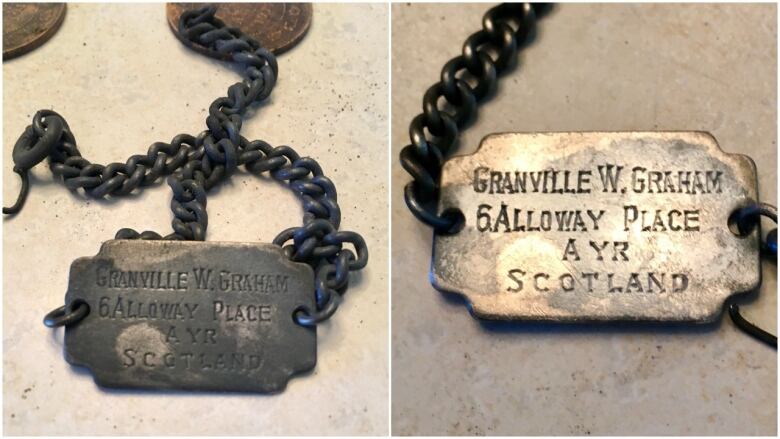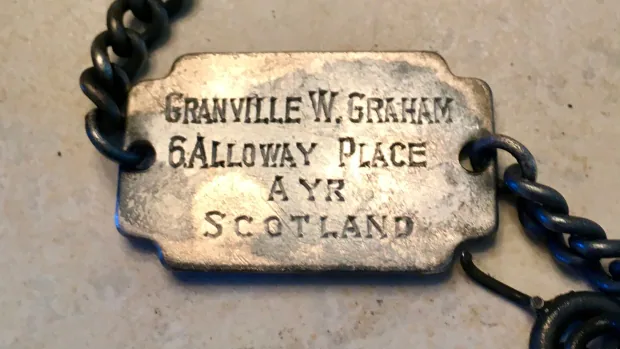As the late fall winds blew cold across Lake Winnipeg and the deserted shoreline, Randy Gerylo did one more sweep with his metal detector — a decision that plunged him into military history and led to a widow in the U.K.

As the late fall winds blew cold across Lake Winnipeg and the deserted shoreline, Randy Gerylo did one more sweep with his metal detector — a decision that plunged him into military history and led to a pilot’s widow in the U.K.
Gerylo’s discovery last November of a serviceman’s long-lost ID bracelet prompted a search that traversed a half-century in time and a distance of 5,800 kilometres, from Gimli, Man., to Ayr in Scotland.
It has also generated the greatest tale in his three decades of detecting.
“Everything you find tells a story, but this one told a little more. This was something that was a little more special,” said Gerylo, 61.
It was Nov. 8, 2021 — “my last detecting outing of the year” — and he had gathered up a medley of routine items: bits of jewelry, coins, bottle caps and pull tabs from cans.
That’s when his device pinged on something else just off the edge of the water. About 15 centimetres under cold sand, Gerylo pulled up a thick chain and its name plate.

“It was pretty tarnished — I guess it was sitting there for such a long time. However, I could see that it was engraved,” he said.
That inscription read: Granville W. Graham, 6 Alloway Place, Ayr, Scotland.
Ayr, in western Scotland, is on the coast of the Firth of Clyde, which joins with the North Atlantic Ocean.
“As soon as I saw it, right away I thought, ‘oh, I gotta find the owner or maybe family members … and get it back to them,'” Gerylo said.

He went to a Manitoba metal-detecting Facebook forum for tips, which led him to similar forums in Scotland. Word spread and some U.K. media outlets picked up the story.
It took two or three weeks, with the help of amateur Scottish history sleuths, to discover Graham had died in 2019 at age 86. So Gerylo pursued family members, which took much longer.
“I had almost actually given up,” he said.
In January, an article about the hunt for Graham’s family was published in some local and online newspapers and a member of the Royal British Legion Scotland spotted it.
Elliot Thomson, veterans community support co-ordinator with the legion, was able to determine Graham had been a member of the service and that most people knew him by his nickname — Jock, rather than Granville.
That information, in turn, revealed the connection to Gimli. Graham had been a member of the U.K.’s Royal Air Force and was stationed there in the late 1950s and early 1960s.

The Canadian Forces Base in Gimli — about 100 kilometres north of Winnipeg — was originally established in 1943 under the British Commonwealth Air Training Plan as a flying training school.
It closed in 1945 but was reactivated in 1950 during the Cold War, when it became a training station for jet pilots from North Atlantic Treaty Organization member countries.
It eventually closed again in 1971, but the airstrip remained (and gained international attention in the 1983 “Gimli Glider” incident, when a Boeing 767 that ran out of fuel used the old runway for an emergency landing).
According to the Ayrshire Post newspaper, Thomson tracked down Graham’s widow, Margaret, and told her about the latest Canadian connection. She was unaware her late husband had ever lost his ID bracelet in Canada.
“The next step was trying to get that bracelet back to her,” said Gerylo, who never had the opportunity to speak to Margaret. The liaison work was all done through the legion’s support office, he said.
Despite concerns it might get lost in the mail, Gerylo shipped it off and it arrived on Margaret’s doorstep in Ayr about two weeks later, in mid-February.

The legion sent him a photo of the bracelet being presented to her by a support member.
“That was an exciting moment,” Gerylo said. “It was great that it came to a conclusion and she was able to physically have it in her hands as a lasting memento.”
Important fragment of past: historical society
Gord Crossley, heritage officer for 17 Wing Canadian Forces Base in Winnipeg, has helped reunite families with military medals, sometimes found in thrift shops.
It’s always a big deal, he said — not just because of the emotion involved, but also because of the effort required to find relatives. Social media and online databases have vastly improved that process.
“I don’t think this [repatriating Graham’s bracelet] would have been possible 20-some years ago, or it would have been a very slow process,” Crossley said.
Now, “with a few clicks and a few word searches you can make connections very quickly.”

Information Radio – MB5:59How did a sixty-year-old bracelet from Scotland end up on a beach in Gimli? A metal dectorist found out.
After Randy Gerylo found a mysterious bracelet on the shores of Lake Winnipeg he embarked on a quest to find its owner . . . in Scotland. He told CBC’s Faith Fundal how it went. 5:59
Bill Zuk, director at the Canadian Aviation Historical Society, compared the bracelet to the more familiar military dog tags worn around soldiers’ necks.
“Those were the only identification, in some cases, of war dead. So they were really important,” he said, adding they would be shipped back to mourning family members.
During the Second World War and after, it was common to have bracelets with that information, said Zuk, who comes from a family of seven war veterans.
He doesn’t know Graham’s widow but can imagine how poignant it was to get that bracelet.
“Having a fragment of her past and her life with her husband come back to her, that’s a pretty emotional time,” he said.
Crossley and Zuk said the bracelet also helped resurface important history people might not know about in Gimli.

“We were training pilots from France, the U.K. and all that here in Canada,” Crossley said.
“The connection with Gimli and the community … [is] pretty amazing,” said Zuk.
For Gerylo, the experience has shored up his passion for detecting and the wonderment it can yield.
“You never know what the next thing is that’s going to be coming out of the ground,” he said. “This was an interesting object and it was probably sitting there for 60-something years, waiting. Now it’s back home in Scotland.”
His only regret is that he didn’t locate it a couple of years earlier and get it back into the hands of Graham himself.
“Maybe I would have heard the whole story about how he lost it.”


